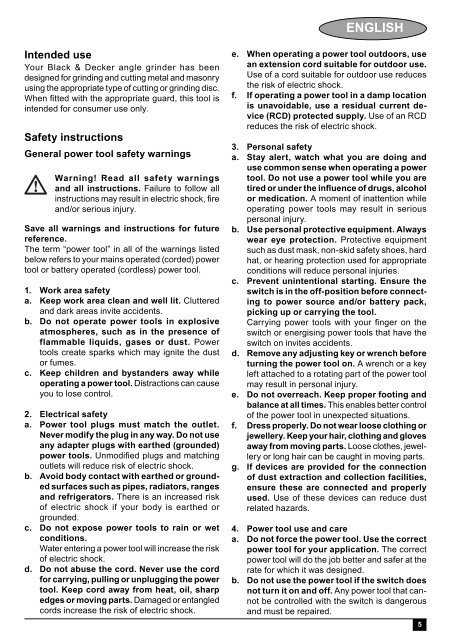BlackandDecker Smerigliatrice Angolare Piccola- Cd110 - Type 4 - Instruction Manual (Europeo Orientale)
BlackandDecker Smerigliatrice Angolare Piccola- Cd110 - Type 4 - Instruction Manual (Europeo Orientale)
BlackandDecker Smerigliatrice Angolare Piccola- Cd110 - Type 4 - Instruction Manual (Europeo Orientale)
You also want an ePaper? Increase the reach of your titles
YUMPU automatically turns print PDFs into web optimized ePapers that Google loves.
ENGLISH<br />
Intended use<br />
Your Black & Decker angle grinder has been<br />
designed for grinding and cutting metal and masonry<br />
using the appropriate type of cutting or grinding disc.<br />
When fi tted with the appropriate guard, this tool is<br />
intended for consumer use only.<br />
Safety instructions<br />
General power tool safety warnings<br />
Warning! Read all safety warnings<br />
and all instructions. Failure to follow all<br />
instructions may result in electric shock, fi re<br />
and/or serious injury.<br />
Save all warnings and instructions for future<br />
reference.<br />
The term “power tool” in all of the warnings listed<br />
below refers to your mains operated (corded) power<br />
tool or battery operated (cordless) power tool.<br />
1. Work area safety<br />
a. Keep work area clean and well lit. Cluttered<br />
and dark areas invite accidents.<br />
b. Do not operate power tools in explosive<br />
atmospheres, such as in the presence of<br />
flammable liquids, gases or dust. Power<br />
tools create sparks which may ignite the dust<br />
or fumes.<br />
c. Keep children and bystanders away while<br />
operating a power tool. Distractions can cause<br />
you to lose control.<br />
2. Electrical safety<br />
a. Power tool plugs must match the outlet.<br />
Never modify the plug in any way. Do not use<br />
any adapter plugs with earthed (grounded)<br />
power tools. Unmodifi ed plugs and matching<br />
outlets will reduce risk of electric shock.<br />
b. Avoid body contact with earthed or grounded<br />
surfaces such as pipes, radiators, ranges<br />
and refrigerators. There is an increased risk<br />
of electric shock if your body is earthed or<br />
grounded.<br />
c. Do not expose power tools to rain or wet<br />
conditions.<br />
Water entering a power tool will increase the risk<br />
of electric shock.<br />
d. Do not abuse the cord. Never use the cord<br />
for carrying, pulling or unplugging the power<br />
tool. Keep cord away from heat, oil, sharp<br />
edges or moving parts. Damaged or entangled<br />
cords increase the risk of electric shock.<br />
e. When operating a power tool outdoors, use<br />
an extension cord suitable for outdoor use.<br />
Use of a cord suitable for outdoor use reduces<br />
the risk of electric shock.<br />
f. If operating a power tool in a damp location<br />
is unavoidable, use a residual current device<br />
(RCD) protected supply. Use of an RCD<br />
reduces the risk of electric shock.<br />
3. Personal safety<br />
a. Stay alert, watch what you are doing and<br />
use common sense when operating a power<br />
tool. Do not use a power tool while you are<br />
tired or under the influence of drugs, alcohol<br />
or medication. A moment of inattention while<br />
operating power tools may result in serious<br />
personal injury.<br />
b. Use personal protective equipment. Always<br />
wear eye protection. Protective equipment<br />
such as dust mask, non-skid safety shoes, hard<br />
hat, or hearing protection used for appropriate<br />
conditions will reduce personal injuries.<br />
c. Prevent unintentional starting. Ensure the<br />
switch is in the off-position before connecting<br />
to power source and/or battery pack,<br />
picking up or carrying the tool.<br />
Carrying power tools with your fi nger on the<br />
switch or energising power tools that have the<br />
switch on invites accidents.<br />
d. Remove any adjusting key or wrench before<br />
turning the power tool on. A wrench or a key<br />
left attached to a rotating part of the power tool<br />
may result in personal injury.<br />
e. Do not overreach. Keep proper footing and<br />
balance at all times. This enables better control<br />
of the power tool in unexpected situations.<br />
f. Dress properly. Do not wear loose clothing or<br />
jewellery. Keep your hair, clothing and gloves<br />
away from moving parts. Loose clothes, jewellery<br />
or long hair can be caught in moving parts.<br />
g. If devices are provided for the connection<br />
of dust extraction and collection facilities,<br />
ensure these are connected and properly<br />
used. Use of these devices can reduce dust<br />
related hazards.<br />
4. Power tool use and care<br />
a. Do not force the power tool. Use the correct<br />
power tool for your application. The correct<br />
power tool will do the job better and safer at the<br />
rate for which it was designed.<br />
b. Do not use the power tool if the switch does<br />
not turn it on and off. Any power tool that cannot<br />
be controlled with the switch is dangerous<br />
and must be repaired.<br />
5
















